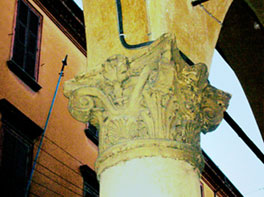|
BED AND BREAKFAST IN BOLOGNA ACCOMMODATION IN BOLOGNA ERBORISTERIA WEBMASTER |
||||||
|
|
King Enzo, the illegitimate son of the emperor Frederick
11 was the great Ghibelline personality in Bologna. On May26th, 1249, the
Guelphes won their first pitched battle against the troops of the Emperor,
near Modena, on the Via Emilia, at the Fossalta bridge. On this same day,
among the Modenese Ghibellines the Bologna Guelphes took the Emperor's
son prisoner and put him in the "Palatium Novum" (later called "of King
Enzo"), built adjoining the "Palatium Vetus" (called "of the Podesta")
between 1244 and 1246. The building is one of the most
rapresentative in the main square of the town, Piazza Maggiore. On
King Enzo's imprisonment there was great festivity. He remained in this
palace until his death in 1272. He became part of the Bologna legend and the anniversary of his capture gave the
opportunity to celebrate every year "la festa dell a porchetta" (roasted
pig's day) which was held until the 18th Century to evoke the Guelf
tradition of the city. King Enzo's Palace was extensively restored by
Rubbiani at the beginning of this century. After the Fossalta victory, the
Guelphes ( Pope's suppporters) increase their power in order to drive away
the Ghibellines (Emperor's supporters) in 1274. |
|
b u |
|||
|
General - Environment - Iron and Etruscan Age - Roman Age - Patron Saint- The Commune - Alma mater studiorum - Re Enzo - Porticoes - St Peter - Gothic - 14th Century - Piazza Maggiore - Aristocratic palaces - Brick and other stones - Early 15th Century - Archiginnasio - Counter Reformation Renaissance - 16th Century - Great portico ribbons - Frescoes in palaces - The "scenographic" city - Napoleon's republics - Fall of Church power - The Restoration - Haussmann style - The new Century - Floreal style - Rationalism - World War - Active preservation - Around 2000 |
||||||
